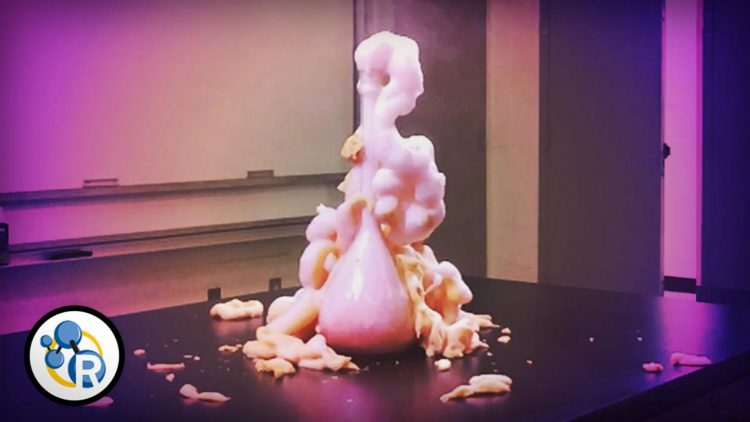Foam explosion in super slow motion (video)

You might have seen this wacky experiment in a chemistry class or on late-night TV. Dropping a mixture into some hydrogen peroxide produces a huge foamy flume. But what's actually causing that big mess? Turns out it's a great illustration of a key concept in chemistry. In this week's video, Reactions teams up with chemistry professor Matt Hartings, Ph.D., to explain the Elephant Toothpaste experiment. Check it out here: https://youtu.be/PX7TIqAJRSY. Credit: The American Chemical Society
Dropping a mixture into some hydrogen peroxide produces a huge foamy flume. But what's actually causing that big mess?
Turns out it's a great illustration of a key concept in chemistry.
In this week's video, Reactions teams up with chemistry professor Matt Hartings, Ph.D., to explain the Elephant Toothpaste experiment.
Check it out here: https:/
###
Subscribe to the series at http://bit.
The American Chemical Society is a nonprofit organization chartered by the U.S. Congress. With more than 158,000 members, ACS is the world's largest scientific society and a global leader in providing access to chemistry-related research through its multiple databases, peer-reviewed journals and scientific conferences. Its main offices are in Washington, D.C., and Columbus, Ohio.
To automatically receive news releases from the American Chemical Society, contact newsroom@acs.org.
Media Contact
All latest news from the category: Life Sciences and Chemistry
Articles and reports from the Life Sciences and chemistry area deal with applied and basic research into modern biology, chemistry and human medicine.
Valuable information can be found on a range of life sciences fields including bacteriology, biochemistry, bionics, bioinformatics, biophysics, biotechnology, genetics, geobotany, human biology, marine biology, microbiology, molecular biology, cellular biology, zoology, bioinorganic chemistry, microchemistry and environmental chemistry.
Newest articles

First-of-its-kind study uses remote sensing to monitor plastic debris in rivers and lakes
Remote sensing creates a cost-effective solution to monitoring plastic pollution. A first-of-its-kind study from researchers at the University of Minnesota Twin Cities shows how remote sensing can help monitor and…

Laser-based artificial neuron mimics nerve cell functions at lightning speed
With a processing speed a billion times faster than nature, chip-based laser neuron could help advance AI tasks such as pattern recognition and sequence prediction. Researchers have developed a laser-based…

Optimising the processing of plastic waste
Just one look in the yellow bin reveals a colourful jumble of different types of plastic. However, the purer and more uniform plastic waste is, the easier it is to…



